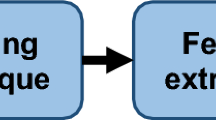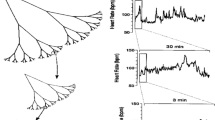Abstract
Acoustical properties of snoring signal have been widely studied as a potentially cost-effective and reliable alternative to diagnosing obstructive sleep apnea hypopnea syndrome, with a common recognition that the diagnostic accuracy depends heavily on the snoring signal quality. In the paper, generalized subspace noise reduction based on noise covariance matrix estimate is proposed. The noise covariance matrix is the Toeplitz matrix of the unbiased autocorrelation sequence which is estimated by recursive averaging its past value adjusted by a time-varying smoothing parameter controlled by the snoring signal presence probability, and the signal presence is determined by the ratio of temporal frame autocorrelation value to its minimum absolute value. The proposed method has a better estimate of noise covariance matrix, and the results of objective quality measurements and spectrograms of snoring signal show obvious improvement in terms of noise reduction and signal distortion under different non-stationary noise environments compared with conventional subspace enhancement algorithm.





Similar content being viewed by others
Data Availability Statement
The data used to support the findings of this study are available from the corresponding author upon request.
References
A. Azarbarzin, Z. Moussavi, Snoring sounds variability as a signature of obstructive sleep apnea. Med. Eng. Phys. 35(4), 479–485 (2013)
S. Boll, Suppression of acoustic noise in speech using spectral subtraction. IEEE Trans. Acoust. Speech Signal Process. 27(2), 113–120 (1979)
I. Cohen, B. Berdugo, Noise estimation by minima controlled recursive averaging for robust speech enhancement. IEEE Signal Process. Lett. 9(1), 12–15 (2002)
E. Dafna, A. Tarasiuk, Y. Zigel, Automatic detection of whole night snoring events using non-contact microphone. PLoS ONE 8(12), e84139 (2013)
R. Dahlan, AdaBoost noise estimator for subspace based speech enhancement, in 2018 International Conference on Computer, Control, Informatics and its Applications: Recent Challenges in Machine Learning for Computing Applications, IC3INA 2018—Proceeding (2019), pp. 110–113
M. Dendrinos, S. Bakamidis, G. Carayannis, Speech enhancement from noise: a regenerative approach. Speech Commun. 10(1), 45–57 (1991)
Y. Ephraim, D. Malah, Speech enhancement using a minimum mean-square error log-spectral amplitude estimator. IEEE Trans. Acoust. Speech Signal Process. 33(2), 443–445 (1985)
Y. Ephraim, H.L. Van Trees, A signal subspace approach for speech enhancement. IEEE Trans. Speech Audio Process. 3(4), 251–266 (1995)
G. Farahani, S.M. Ahadi, M.M. Homayounr, A. Kashi, Robust feature extraction using spectral peaks of the filtered higher lag autocorrelation sequence of the speech signal, in 2006 IEEE International Symposium on Signal Processing and Information Technology (IEEE, New York, 2006), pp. 896–901
G. Farahani, Autocorrelation-based noise subtraction method with smoothing, overestimation, energy, and cepstral mean and variance normalization for noisy speech recognition. Eurasip J. Audio Speech Music Process. 1, 2017 (2017)
N. Faraji, S.M. Ahadi, Improved subspace-based speech enhancement using a novel updating approach for noise correlation matrix, in 2015 Signal Processing and Intelligent Systems Conference (SPIS) (IEEE, New York, 2015), pp. 88–92
E. Grivel, M. Gabrea, M. Najim, Speech enhancement as a realisation issue. Signal Process. 82(12), 1963–1978 (2002)
Y. Hu, P.C. Loizou, A generalized subspace approach for enhancing speech corrupted by colored noise. IEEE Trans. Speech Audio Process. 11(44), 334–341 (2003)
F. Jabloun, B. Champagne, Incorporating the human hearing properties in the signal subspace approach for speech enhancement. IEEE Trans. Speech Audio Process. 11(6), 700–708 (2003)
S.H. Jensen, P.C. Hansen, S.D. Hansen, J.A. Sorensen, Reduction of broad-band noise in speech by truncated QSVD. IEEE Trans. Speech Audio Process. 3(6), 439–448 (1995)
T. Jiang, R. Liang, Q. Wang, Y. Bao, Speech noise reduction algorithm in digital hearing aids based on an improved sub-band SNR estimation. Circuits Syst. Signal Process. 37(3), 1243–1267 (2018)
Y. Jiang, J. Peng, X. Zhang, Automatic snoring sounds detection from sleep sounds based on deep learning. Phys. Eng. Sci. Med. 43(2), 679–689 (2020)
A.S. Karunajeewa, U.R. Abeyratne, C. Hukins, Silence-breathing-snore classification from snore-related sounds. Physiol. Meas. 29(2), 227–243 (2008)
P.C. Loizou, Speech enhancement: theory and practice (CRC Press, Boca Raton, 2013)
R. Martin, Noise power spectral density estimation based on optimal smoothing and minimum statistics. IEEE Trans. Speech Audio Process. 9(5), 504–512 (2001)
R. Martin, D. Malah, R.V. Cox, A.J. Accardi, A noise reduction preprocessor for mobile voice communication. EURASIP J. Adv. Signal Process. 2004(8), 147306 (2004)
L.T. McWhorter, L.L. Scharf, Multiwindow estimators of correlation. IEEE Trans. Signal Process. 46(2), 440–448 (1998)
S. Miyazaki, Y. Itasaka, K. Ishikawa, K. Togawa, Acoustic analysis of snoring and the site of airway obstruction in sleep related respiratory disorders. Acta Otolaryngol. Suppl. 118(537), 47–51 (1998)
S.M. Mousavi, N. Alikar, S.T. Akhavan Niaki, Seyed Mohsen Mousavi, An improved fruit fly optimization algorithm to solve the homogeneous fuzzy series-parallel redundancy allocation problem under discount strategies. Soft. Comput. 20(6), 2281–2307 (2016)
A.K. Ng, T.S. Koh, K. Puvanendran, U.R. Abeyratne, Snore signal enhancement and activity detection via translation-invariant wavelet transform. IEEE Trans. Biomed. Eng. 55(10), 2332–2342 (2008)
P.E.N.G. Jianxin, T.A.N.G. Yunfei, Noise reduction of snoring sound by using traditional spectral subtraction and wiener filter. J. South China Univ. Technol. (Nat. Sci. Ed.) 46(3), 16 (2018)
W.J. Riley, Hamilton Technical Services. Use of the Autocorrelation Function for Frequency Stability Analysis @BULLET Examples of Autocorrelation Plots for Power Law Noise (2003)
A.W. Rix, J.G. Beerends, M.P. Hollier, A.P Hekstra, Perceptual evaluation of speech quality (PESQ)-a new method for speech quality assessment of telephone networks and codecs, in 2001 IEEE International Conference on Acoustics, Speech, and Signal Processing. Proceedings (Cat. No. 01CH37221), vol 2 (IEEE, New York, 2001), pp. 749–752
A. Saadoune, A. Amrouche, S.A. Selouani, MCRA noise estimation for KLT-VRE-based speech enhancement. Int. J. Speech Technol. 16(3), 333–339 (2013)
E. Sejdić, I. Djurović, J. Jiang, Time-frequency feature representation using energy concentration: an overview of recent advances. Digital Signal Process. Rev. J. 19(1), 153–183 (2009)
F.K. Shiomi, I.T. Pisa, C.J.R. de Campos, Computerized analysis of snoring in sleep Apnea Syndrome. Braz. J. Otorhinolaryngol. 77(4), 488–498 (2011)
J. Sun, J. Zhang, M. Small, Extension of the local subspace method to enhancement of speech with colored noise. Signal Process. 88(7), 1881–1888 (2008)
S. Surendran, T.K. Kumar, Variance normalized perceptual subspace speech enhancement. AEU Int. J. Electron. Commun. 74, 44–54 (2017)
M. Thiagarajan, J. Natarajan, K.M. Sharavanaraju, Pitch-based voice activity detection for feedback cancellation and noise reduction in hearing aids. Circuits Syst. Signal Process. 37(10), 4504–4526 (2018)
A. Varga, H.J.M. Steeneken, Assessment for automatic speech recognition: II. NOISEX-92: a database and an experiment to study the effect of additive noise on speech recognition systems. Speech Commun. 12, 247–251 (1993)
X. Xie, D. Yue, J.H. Park, Observer-based fault estimation for discrete-time nonlinear systems and its application: a weighted switching approach. IEEE Trans. Circuits Syst. I Regul. Pap. 66(11), 4377–4387 (2019)
H. Xu, W. Huang, L. Yu, L. Chen, Sound spectral analysis of snoring sound and site of obstruction in obstructive sleep apnea syndrome. Acta Otolaryngol. 130(10), 1175–1179 (2010)
C.H. You, S.N. Koh, S. Rahardja, An invertible frequency eigendomain transformation for masking-based subspace speech enhancement. IEEE Signal Process. Lett. 12(6), 461–464 (2005)
C.H. You, S.N. Koh, S. Rahardja, Signal subspace speech enhancement for audible noise reduction, in Proceedings IEEE International Conference on Acoustics, Speech, and Signal Processing, 2005 (ICASSP’05), vol 1 (IEEE, New York, 2005), pp. 1–145
Acknowledgements
This work was supported by National Natural Science Foundation of China under Grant Nos. 11974121, 81570904 and National Youth Foundation of China under Grant No. 81900927.
Author information
Authors and Affiliations
Corresponding author
Ethics declarations
Conflicts of interest
The authors declared no potential conflicts of interest with respect to the research, authorship and/or publication of this article.
Ethical Approval
This study was approved by the Ethics Committee of Guangzhou Medical University, and an informed consent was obtained from each participant.
Additional information
Publisher's Note
Springer Nature remains neutral with regard to jurisdictional claims in published maps and institutional affiliations.
Rights and permissions
About this article
Cite this article
Ding, L., Peng, J., Jiang, Y. et al. Generalized Subspace Snoring Signal Enhancement Based on Noise Covariance Matrix Estimation. Circuits Syst Signal Process 40, 3355–3373 (2021). https://doi.org/10.1007/s00034-020-01623-3
Received:
Revised:
Accepted:
Published:
Issue Date:
DOI: https://doi.org/10.1007/s00034-020-01623-3




